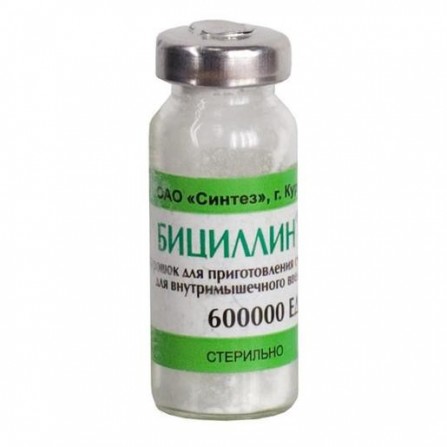Bicillin-3 powder for injection 600tys. units N50
Condition: New product
1000 Items
Rating:
Be the first to write a review!

More info
Description
Bicillin-3 is a combination drug with a narrow spectrum of antibacterial action. Available in powder form for suspension and subsequent intramuscular administration. It is active against gram-positive bacteria, such as staphylococci, streptococci, enterococci, corynebacteria of diphtheria, listeria, clostridia, anaerobic spore-forming bacillus of the genus Bacillus, gram-negative bacteria: gonococci, meningococci, actinomycetes, spirochetes.
Active ingredients
Benzatine Benzylpenicillin + Benzylpenicillin Procaine
Release form
Powder
Composition
Benzatin benzylpenicillin, benzylpenicillin sodium salt, benzylpenicillin novocainic salt.
Pharmacological effect
Antibacterial, bactericidal. Suppresses the synthesis of cell walls of microorganisms.
Pharmacokinetics
After intramuscular administration, it is slowly absorbed to release benzylpenicillin. With a single injection is maintained at an average therapeutic concentration of 6-7 days. The time required to reach the maximum concentration (TCmax) in plasma is 12-24 h after injection. Penetration in fluid is high, in tissue - low. Communication with plasma proteins - 40-60%. Gets through a placental barrier, it is found in mother's milk. Metabolized slightly, mainly excreted by the kidneys in unchanged form.
Indications
Infections (in adults) caused by susceptible microorganisms: syphilis and other diseases caused by pale treponema (yaws), streptococcal infections (excluding infections in group B streptococcus) - acute tonsillitis, scarlet fever, wound infections, erysipelas, rheumatism (prevention) .
Contraindications
Hypersensitivity to drugs of the penicillin group and other beta-lactam antibiotics, to procaine.
Precautionary measures
To take with caution in renal failure, allergic diseases, including bronchial asthma, pollinosis (including history), pseudomembranous colitis.
Use during pregnancy and lactation
In pregnancy, it is possible only when the intended benefit to the mother outweighs the potential risk to the fetus. If necessary, the use of the drug during lactation should decide on the termination of breastfeeding.
Dosage and administration
Introduced deeply intramuscularly into the upper outer quadrant of the gluteus muscle in a dose of 300 thousand U. If necessary, 2 injections are made into different buttocks. Repeated injections produced on 4 days after the previous injection. At a dose of 600 thousand units enter 1 time in 6 days. In the treatment of primary and secondary syphilis, a single dose of the drug is 1.8 million U. The course of treatment consists of 7 injections. The first injection is carried out at a dose of 300 thousand U.S., the second injection - after 1 day in a full single dose, the subsequent injections are carried out 2 times a week in a full single dose. In the treatment of secondary recurrent and latent early syphilis, a dose of 300 thousand units is used for the first injection, for subsequent injections - 1.8 million units. Injections are carried out 2 times a week. The course of treatment is 14 injections.
Side effects
Allergic reactions: urticaria, angioedema, erythema multiforme, anaphylactic shock, arthralgia, fever, exfoliative edema. On the part of the digestive system: stomatitis, glossitis. On the side of the blood coagulation system: anemia, thrombocytopenia, leukopenia, onset. superinfection, mycoses.
Interaction with other drugs
Synergy with simultaneous use with bactericidal antibiotics (including cephalosporins, cycloserine, vancomycin, rifampicin, aminoglycosides), Antagonism with bacteriostatic antibiotics (including macrolides, chloramphenicol, linkosamides, tetracyclines), Bicillin-3 is effective. and ethinyl estradiol (the risk of breakthrough bleeding), the simultaneous use of Bicillin-3 with allopurinol increases the risk of allergic reactions.
special instructions
The use of the drug in insufficient doses or early cessation of treatment leads to the emergence of resistant strains of pathogens.


